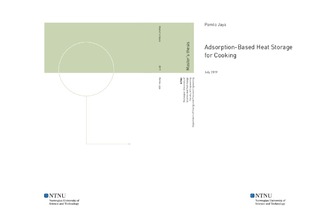| dc.description.abstract | With the increasing effort to develop renewable technology, chemical heat storage has become more and more attractive. By using this type of storage, the heat dissipation issue is solved by storing the energy in the form of chemical potential. Moreover, with the motivation to find the cooking solution in rural African area without access to electricity, a study carried out to find a heat storage solution that can be used on a day and night.
The previous feasibility study has resulted in the salt-ammonia system as the potential candidate to be developed. As the first step, the laboratory prototype is designed and built. The simple prototype then used to demonstrate the charging and discharging concept of this system. Several discharging and charging tests with various circumstances is carried out, and the result has shown that the temperature difference between low-temperature salt and surrounding plays a vital role to control heat output in hot-temperature salt.
Even though the discharge output of 200°C has yet to be achieved, numerous indications during the tests suggest that the potential to achieve this goal is still there. As a continuation, a research idea to improve the process has been proposed. In addition, recommendations have been made to improve the measurement accuracy of the prototype. | |
